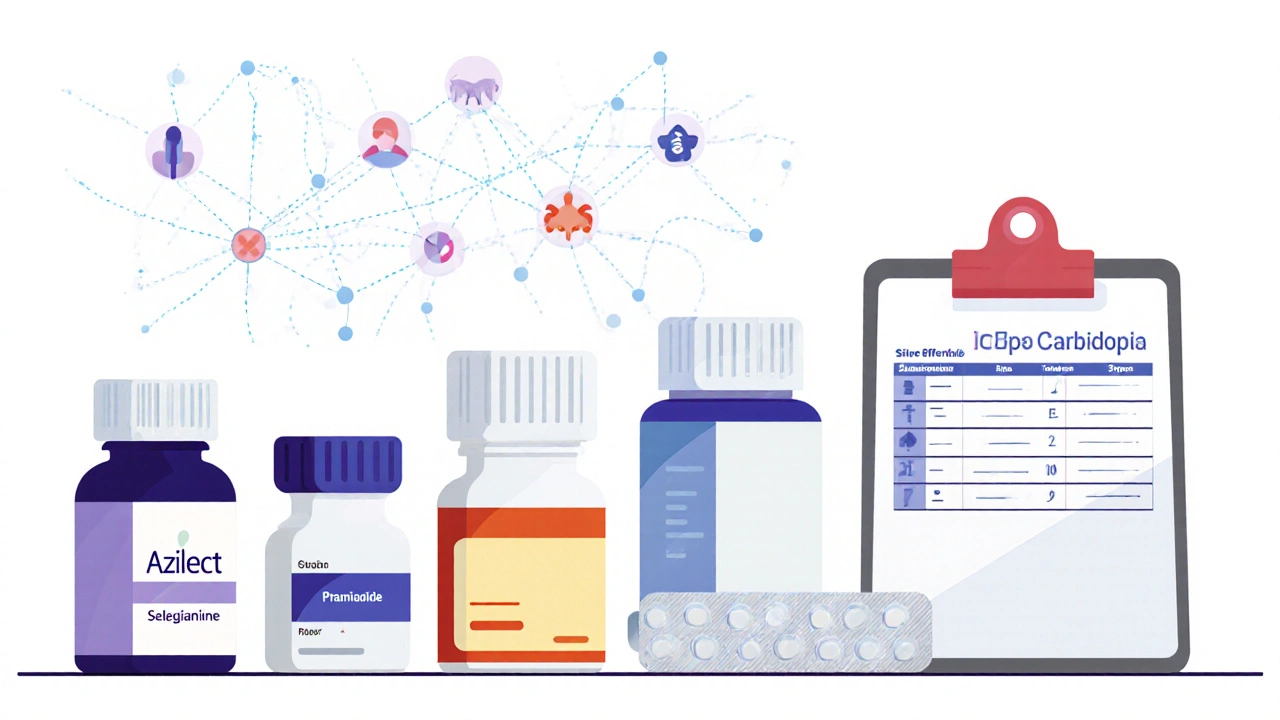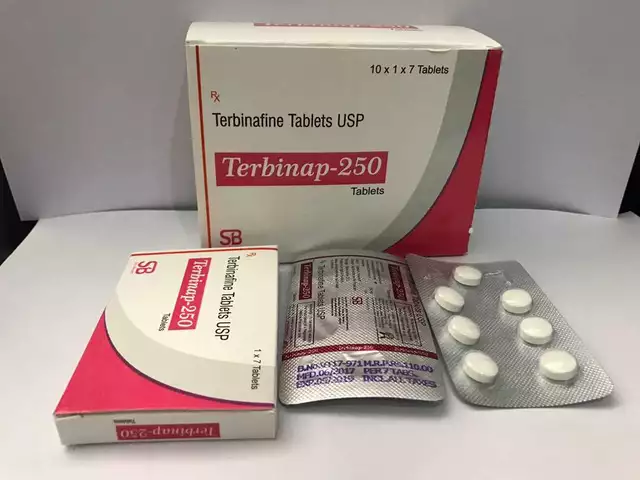Azilect vs Other Parkinson's Drugs Comparison Tool
Azilect (Rasagiline)
Class: Irreversible MAO-B Inhibitor
Dosage: Once daily, 1 mg
Dietary Restrictions: None
Key Benefit: Minimal side effects, no dietary restrictions
Selegiline
Class: Reversible MAO-B Inhibitor
Dosage: Twice daily
Dietary Restrictions: Low tyramine diet required
Key Benefit: Long-established treatment
Safinamide
Class: Reversible MAO-B Inhibitor with Glutamate Modulation
Dosage: Once daily, 100 mg
Dietary Restrictions: None
Key Benefit: Potential neuroprotective effects
Pramipexole
Class: Dopamine Agonist
Dosage: Usually 3 times daily
Dietary Restrictions: None
Key Benefit: Effective for early-stage symptoms
Side Effect Comparison Table
| Drug | Common Side Effects | Serious Risks |
|---|---|---|
| Azilect | Headache, joint pain, insomnia | Rare hypertensive crisis |
| Selegiline | Nausea, dizziness, dry mouth | Hypertensive reactions with high-tyramine foods |
| Safinamide | Back pain, nausea, dyskinesia | Severe hypertension if combined with certain antidepressants |
| Pramipexole | Sleepiness, sudden sleep attacks, hallucinations | Impulse control disorders |
| Levodopa/Carbidopa | Nausea, orthostatic hypotension, dizziness | Long-term dyskinesia and motor fluctuations |
Cost Comparison (UK - Monthly)
| Drug | Private Cost (£) | NHS Prescription Charge (£) |
|---|---|---|
| Azilect 1 mg | 45–55 | 9.35 |
| Selegiline 10 mg | 30–40 | 9.35 |
| Safinamide 100 mg | 70–80 | 9.35 |
| Pramipexole 0.25 mg | 50–60 | 9.35 |
| Levodopa/Carbidopa | 20–30 | 9.35 |
Azilect is the brand name for rasagiline, a once‑daily oral drug used to treat Parkinson’s disease. It belongs to the class of MAO‑B inhibitors that help preserve dopamine in the brain, easing motor symptoms such as tremor and stiffness. For anyone weighing whether Azilect fits their regimen, understanding how it stacks up against other common Parkinson’s meds is essential.
Quick Takeaways
- Azilect is an irreversible MAO‑B inhibitor taken once a day, usually at 1mg.
- Key alternatives include Selegiline, Safinamide, and dopamine agonists like Pramipexole.
- Azilect tends to have fewer dietary restrictions than older MAO‑B inhibitors.
- Cost varies: the NHS provides a standard prescription charge, while private prices can differ markedly.
- Side‑effect profiles overlap but each drug has distinct risks (e.g., hypertension with selegiline, dyskinesia with high‑dose levodopa).
How Azilect Works
Rasagiline blocks the enzyme monoamine oxidase‑B (MAO‑B), which normally breaks down dopamine. By inhibiting MAO‑B, more dopamine remains available in the synaptic cleft, improving motor control. The drug is irreversible, meaning its effect lasts for the lifespan of the enzyme, so steady benefits appear after a few weeks of treatment. Unlike older MAO‑B inhibitors, rasagiline does not require strict tyramine‑restricted diets because it selectively targets MAO‑B rather than MAO‑A.
Major Alternatives to Consider
When your neurologist mentions “alternatives,” they’re usually talking about other MAO‑B inhibitors or different drug classes altogether.
- Selegiline - a reversible MAO‑B inhibitor available in tablets and transdermal patches. It’s been around since the 1970s and can be dosed twice daily.
- Safinamide - a newer reversible MAO‑B inhibitor that also modulates glutamate release, offering potential neuroprotective effects.
- Levodopa/Carbidopa combos - the gold‑standard for symptom control but associated with motor fluctuations over time.
- Pramipexole - a dopamine agonist that mimics dopamine’s action directly on brain receptors.

Side‑Effect Snapshot
All Parkinson’s drugs share some common adverse events, but nuances matter when you’re choosing a regimen.
| Drug | Typical Side Effects | Serious Risks |
|---|---|---|
| Azilect | Headache, joint pain, insomnia | Rare hypertensive crisis (mostly with high doses) |
| Selegiline | Nausea, dizziness, dry mouth | Potential hypertensive reactions with high‑tyramine foods |
| Safinamide | Back pain, nausea, dyskinesia | Severe hypertension if combined with certain antidepressants |
| Pramipexole | Sleepiness, sudden sleep attacks, hallucinations | Impulse control disorders (e.g., gambling) |
| Levodopa/Carbidopa | Nausea, orthostatic hypotension, dizziness | Long‑term dyskinesia and motor fluctuations |
Cost & Access in the UK
Under the NHS, most Parkinson’s drugs are listed on the Prescription Pricing Authority (PPA) schedule, meaning a standard prescription charge applies (£9.35 as of 2025) for most adults. Private patients may face the following approximate monthly costs:
- Azilect 1mg tablets - £45‑£55
- Selegiline 10mg tablets - £30‑£40
- Safinamide 100mg tablets - £70‑£80
- Pramipexole 0.25mg tablets - £50‑£60
- Levodopa/Carbidopa (standard dose) - £20‑£30
Insurance coverage varies; some private insurers require step‑therapy, meaning they’ll try a cheaper generic before approving the brand‑name drug.
When Azilect May Be the Right Choice
If you’re early in the disease and need a modest boost in dopamine without the fluctuations that come with levodopa, Azilect is a solid option. Its once‑daily dosing fits busy schedules, and the lack of major dietary restrictions simplifies life. Moreover, clinical trials (e.g., the ADAGIO study) suggested a potential disease‑modifying effect at the 1mg dose, though the evidence remains debated.
However, if you’ve already tried a reversible MAO‑B inhibitor like selegiline and experienced hypertensive episodes, you might consider switching to Azilect because its irreversible binding reduces that risk. Conversely, patients who need rapid symptom control often start with levodopa, adding Azilect later as an “add‑on” to smooth out off‑periods.

Practical Tips for Switching or Starting Azilect
- Consult your neurologist for a wash‑out period if you’re moving from another MAO‑B inhibitor - typically 14 days for reversible agents.
- Begin with the 1mg tablet once daily; some clinicians start at 0.5mg for frail patients.
- Monitor blood pressure during the first two weeks, especially if you’re on antihypertensives.
- Keep a symptom diary - note any new headaches or joint pains, which are common early side effects.
- Schedule a follow‑up after 4‑6 weeks to assess motor improvement and decide on dosage adjustments.
Key Takeaway: How Does Azilect Stack Up?
In a nutshell, Azilect offers a convenient, once‑daily MAO‑B blockade with a relatively mild side‑effect profile and no major dietary limits. Compared with selegiline, it’s generally safer regarding hypertensive crises. Safinamide adds glutamate modulation but comes at a higher price. Dopamine agonists like pramipexole can be useful for younger patients but carry risks of sleep attacks and impulse control issues. Levodopa remains the most potent symptom reliever but is best reserved for later stages due to long‑term dyskinesia risk.
Ultimately, the “best” choice hinges on disease stage, comorbidities, cost considerations, and personal lifestyle. Talk openly with your specialist, weigh these factors, and you’ll land on a plan that suits you.
Frequently Asked Questions
Can I take Azilect with other Parkinson’s drugs?
Yes, Azilect is often added to levodopa or dopamine agonists to smooth out motor fluctuations. However, avoid combining it with other MAO‑B inhibitors without a wash‑out period, as this can increase the risk of side effects.
Do I need to follow a low‑tyramine diet while on Azilect?
No. Unlike older MAO‑A inhibitors, rasagiline’s selectivity for MAO‑B means you can eat normal foods like cheese, wine, and soy without worrying about hypertensive crises.
How long does it take to feel the effects of Azilect?
Most patients notice a modest improvement within 2‑4 weeks, although full benefits may take up to 8 weeks as the drug builds up in the brain.
Is Azilect covered by the NHS?
Yes, Azilect is listed on the NHS drug tariff, so it is available with the standard prescription charge. Private prescriptions may be more expensive.
What should I do if I experience headaches or joint pain?
These are common early side effects. Monitor the intensity for a week; if they persist or worsen, contact your doctor. Often the symptoms subside as your body adjusts.
If you’re weighing options, remember that personalized care beats a one‑size‑fits‑all chart. Discuss your lifestyle, budget, and treatment goals with a neurologist, and you’ll find the plan that keeps you moving forward.
Azilect offers a reliable, once‑daily boost for many living with Parkinson’s, but the right choice always depends on the whole picture.





Comments (10)